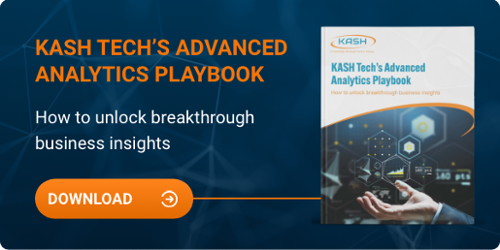Contents
It's Time to Rethink
Data & Analytics Strategies
Our world has changed in amazing ways, which makes this an exciting time to be a leader responsible for business intelligence and analytics. More data is available to make decisions. More people want to make
decisions with data. And more sophisticated analytics are in demand. As a result, many BI and analytics leaders are rethinking their approach to capitalize on these opportunities and enable their organizations to elevate their analytics game.
Their goal is to ensure everyone in the organization is empowered with the insights they need to succeed and prosper, wherever they are and however they work. Innovative leaders have shifted their focus away from
figuring out how to staff up to deal with the backlog of one-off requests. Now, they are focusing on empowering everyone with insights to act, innovate and capitalize on opportunities faster. Innovative leaders are rethinking their strategies along three key dimensions: data, people, and analytical capabilities.
As the world changes, so should your approach to analytics. This introductory guide aims to help those responsible for analytics and business intelligence to rethink their data and analytics strategies to harness their data and empower their people to make faster, more intelligent decisions.
Download Your Personal
Copy of the eBook
-1.png?width=347&height=205&name=Insights%20for%20everyone%20cover%20(1)-1.png)
Fill out the form to receive your copy of the eBook.
Download the eBook
Innovative Leaders are Rethinking 3 Conventional Approaches
The need to centralize data
Who in the organization gets access to insights?
How to serve a spectrum of analytics needs
Innovative leaders are empowering employees to make faster, more intelligent decisions so they can capitalize on opportunities, act faster, and drive innovation.

Rethinking the Need to Centralize Data
Although investments in data and data management have grown exponentially in recent years, including a
massive migration to cloud platforms, most available business data—more than 80%*—is not used to make
decisions.
Conventional thinking dictates that all data needs to be put into a central location before it can be analyzed. However, in this world of disparate data sources (and the 6-9 months it takes IT to add new data sources into a data warehouse), data and analytics leaders are looking for a better and faster way.
More data is being created, aggregated, and consumed today than ever before (here you can see the general shape of the curve). That data is pure potential—if companies can efficiently access and analyze it in a scalable way. The problem is that the tools and processes broadly used for this purpose fall short.
For decades, traditional analytics and BI have been important assets to companies of all sizes. “The first generation of BI solutions was designed around the needs of corporate data warehouses, and they remain a vital part of the business intelligence landscape,” Forbes reported in March 2021. “But with the growth of unstructured data in multiple different sources ... a human being can simply no longer grasp the amount of data that organizations manage.”
According to Deloitte: “Data preprocessing such as cleansing and formatting it for analysis is time-consuming. Some estimates suggest that this can account for 80% of the effort in data analysis projects.”
Without the right infrastructure, this explosive growth in available data can’t be harnessed. With traditional
BI, only technical roles like IT personnel, analysts, and data scientists can leverage the limited data sources supported by these older systems. These technical users must service separate business units across the organization, many of which use disparate tools and work with data outside of approved environments.
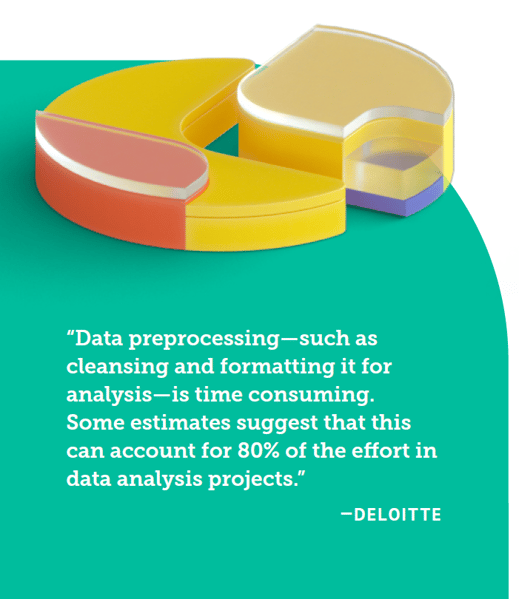
Alternatively, self-service analytics tools—which are often more user-friendly and flexible than traditional
BI systems—are even less capable of building intelligent insights from massive data sets. The process is either prohibitively inefficient or impossible.
Innovative BI and analytics leaders want to present deeper insights by provisioning direct access to any data at scale from multiple data sources in a single view, regardless if it’s on prem, in the cloud or from external data sources.
They want people to query and blend any amount of data at scale with security and governance built in. Unfortunately, their current approach limits them and their organization from reaching this higher level.
* McKinsey & Company
Rethinking Who in the Organization Should Get Access to Insights
Even though more employees want insights to make faster and more intelligent decisions, more than
80%* don’t have access to insights because only an elite few technical people with very specialized skills
know how to use analytics tools.
Indeed, organizations increasingly use a mix of analytics tools across different teams to drive decision-making. This creates inconsistencies and inaccuracies within the organizations.
“25% of organizations use 10 or more BI platforms, 61% of organizations use four or more, and 86% of organizations use two or more,” Forrester reported in August 2021.
This divergence creates data silos that are either inconsistent or incompatible with other business units. When people lose confidence in the data, analytics adoption plummets.
Empowering anyone in an organization with the insights they need to be successful is more important than ever—and increasingly complex.
Business intelligence (BI) and analytics tools developed decades ago, requiring technical skills and training, don’t support the way people need to make decisions today.
Even those analytics and BI professionals and line of business analysts with access to data and
analytics are limited in the insights they can produce for their stakeholders. Most often, their current tools
restrict them. While they can look in the rearview mirror to report on what happened, their limited tools prevent them from predicting what’s next or what to do now to capitalize on opportunities, take corrective actions, or fuel innovation.
*NewVantage Partners Big Data and AI Executive Survey 2021
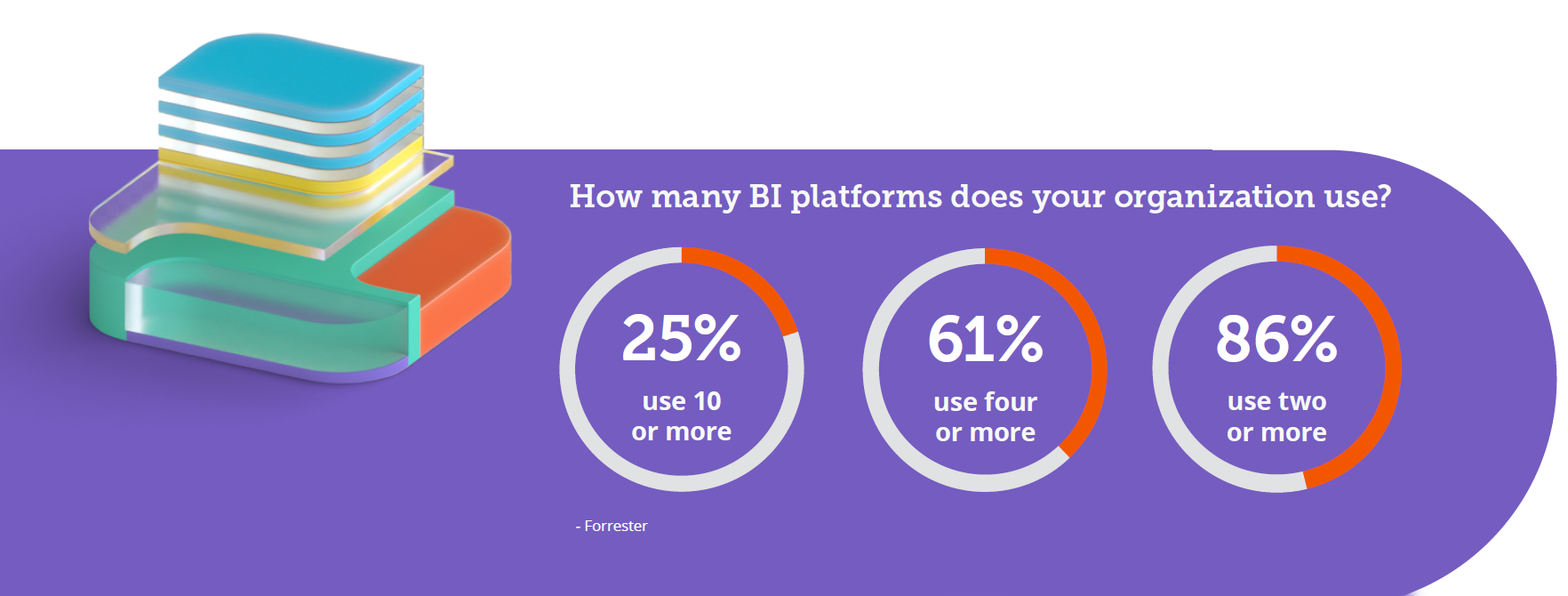
Rethinking the Way They Serve the Spectrum of Analytics Needs
Most large organizations struggle to manage four or more different analytics tools, vendors, support contracts, training programs, and maintenance and infrastructure costs to serve different analytics needs from data prep to business analytics to data science. And different functions like finance, operations, HR, sales, marketing, and other disjointed BI tools often use various business analytics tools to report on KPIs and make decisions.
The result is inconsistent KPI reporting and too much time spent questioning data accuracy rather than using it to make decisions.
Innovative analytics and BI leaders are taking action to address fragmented, segregated, and counterproductive departmental approaches to analytics in favor of a holistic, unified approach that’s
more inclusive across a full spectrum of analytics capabilities. They can meet any analytics needs
from the simple to the sophisticated, addressing the full spectrum of requirements, including descriptive analytics, diagnostic analytics, predictive analytics, and prescriptive analytics. Due to the shortage of data science expertise, they’re offering no-code data science capabilities to those
who need them.
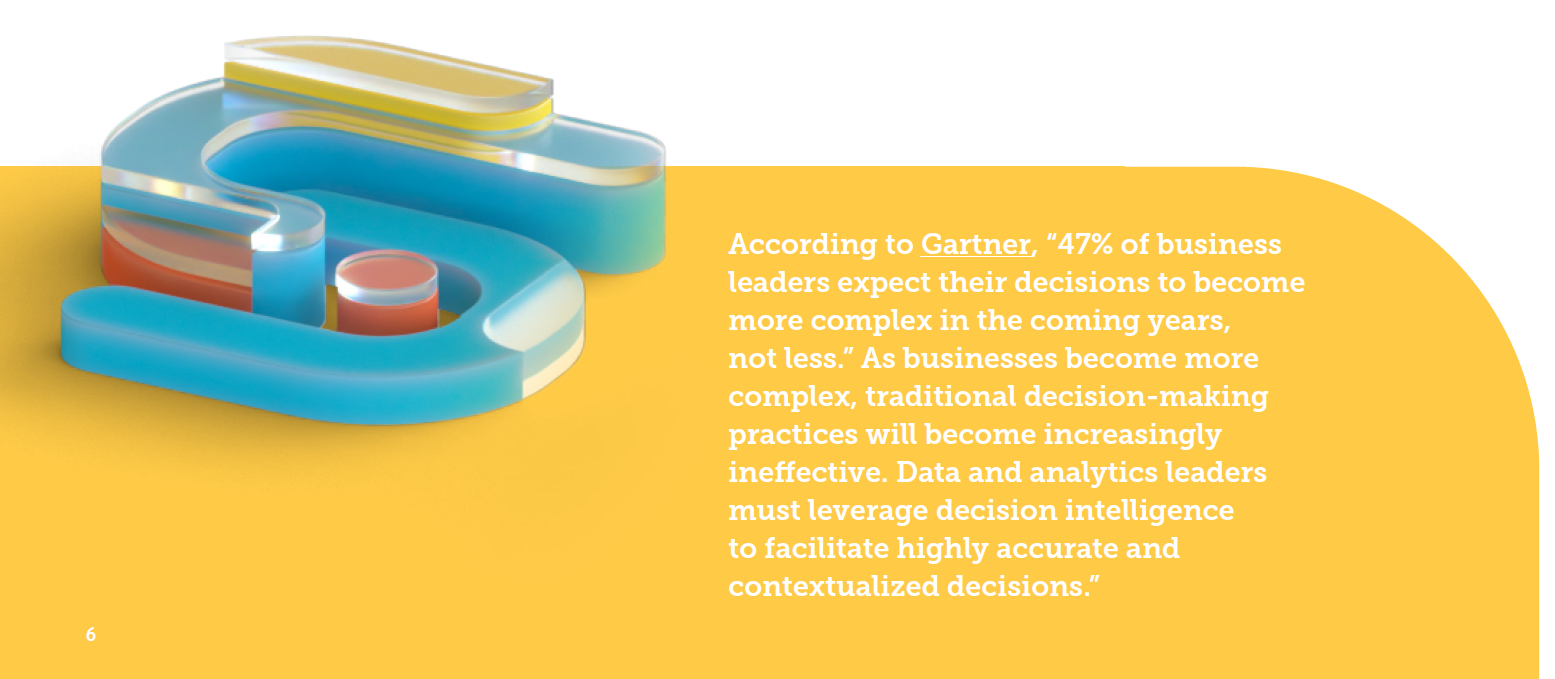
Say Hello to Decision Intelligence:
Data-Driven Decision-Making for the Modern Enterprise
Decision intelligence is what’s next in analytics. It addresses the shortfalls of current fragmented approaches that frustrate the leaders responsible for data and analytics strategies. It is designed to help innovative leaders catapult their organization’s data and analytics capabilities to the next level along three key dimensions: data, people, and analytical capabilities, from the simple to the sophisticated.
Gartner defines decision intelligence as “a practical approach to improve organizational decision making,”
which “models each decision as a set of processes, using intelligence and analytics to inform, learn from,
and refine decisions.”
Simply put, decision intelligence enables data and analytics leaders to empower any person in their
organization—from the C-suite to the frontline and everyone in between—with the insights they need to
make faster, more intelligent decisions, even if they don’t have a technical background in analytics or
data science.
Specifically, a decision intelligence platform can democratize access to data-led insights used for
decision-making. It can provide access to a wider variety of shared data resources, deliver insights
based on that data, and make those insights both sharable and explainable for people in an automated
and governed way. These emphases on access and usability eliminate the need for multiple analytics
tools—a root cause of inaccuracies, confusion, and low analytics adoption at many organizations.
Purpose-built platforms do even more, incorporating an AI-driven, no code experience with governed
self-service.
These features make decision intelligence even more user-friendly for anyone. After all, demand for analytical insights continues to grow among all types of roles and use-cases: 41% of companies have seen increasing requests for analytics where a desire “to make data-driven decisions” is a top reason for their demands, CIO reported in March 2021.
A decision intelligence platform enables innovative leaders to quickly put decision intelligence into practice.
What should you look for in a platform?
Keep in mind: a platform should enable BI and analytics leaders to:
Deliver direct access to any data
Deploy experiences for any person
Easily meet any analytics needs
On the following pages, you’ll read about three organizations that are using the Pyramid Decision Intelligence Platform to solve their particular challenges, both familiar and new.
Business Benefits of Decision Intelligence

Grow revenue & identify new revenue streams

Reduce cost, complexity & risk

Boost productivity by saving time

Case Studies

The Foschini Group (TFG)
Global Retail Group
Provide multi-source direct access to any data at scale in a single view
Companies can capitalize on explosive data growth with decision intelligence. For example, the Pyramid Decision Intelligence Platform is built with a direct query engine at the core. That means our purpose-built analytics platform enables innovative leaders to deliver direct access to any data source, so anyone can connect to, query, and blend any amount of data.
Challenges
Decision Intelligence for Any Data at Any Scale
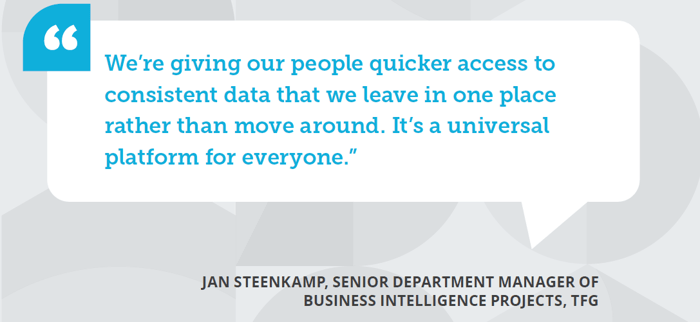

Philadelphia Healthcare
Non-Profit Healthcare Organization
Deploy AI-driven, governed self-service experiences for any person.
People of all skill sets—from C-suite executives to frontline staff—need data-driven insights to be successful. With the right information at their fingertips, people can make data-driven decisions without needing to perform complex calculations (or ask a team member with those skills to help).
The Pyramid Decision Intelligence Platform enables BI and analytics leaders to deliver instant access to any data from any source at any scale so anyone can get answers to questions and take action. By deploying AI-driven, governed self-service experiences for any person, BI and analytics leaders can scale adoption and accelerate their path to building a data-driven decision-making culture. In this way, everyone connects to the
same data sources, with governance, preventing silos within the organization.
When more people use Pyramid, more collaboration, growth, and revenue result—across the enterprise.
Challenges
Siloed reporting: different departments getting different answers to the same questions
Descriptive analytics: legacy reporting only looked back, lacked prescriptive capabilities
Budget restrictions throughout the healthcare sector meant they had to do more with less
Decision Intelligence for Any Person
Enterprise-wide adoption: more than 6,000 people at Philadelphia now use Pyramid
Consistent data: different departments now build intelligence from the same data foundation
Futureproof: transition from prescriptive to diagnostic analytics
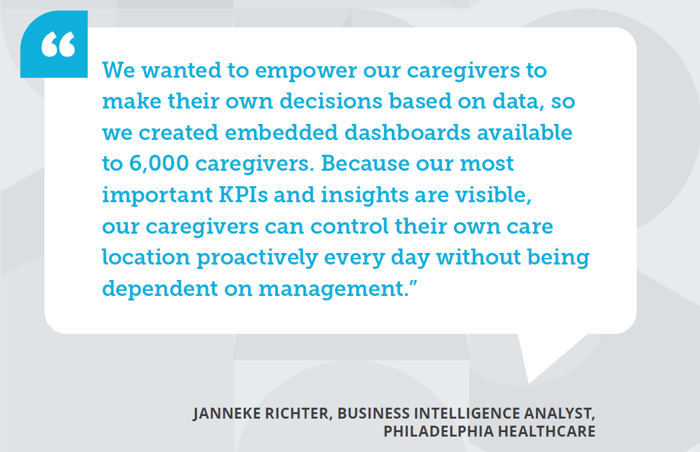

C2FO
Financial Services
Provision any analytics need with frictionless integration.
Decision intelligence provides a unified analytics experience with a frictionless, integrated pipeline across the decision-making process including data prep, business analytics and data science. This integrated approach enables analytics teams to develop analytics assets faster, support a spectrum of analytics needs from the simple to sophisticated, and futureproof analytic assets from data and technology changes.
The Pyramid Platform is designed to consolidate three functional areas along the data and analytics pipeline: data prep, data analytics, and data science. By integrating these key capabilities, people can access data for any of their decisions in a governed way, without writing a single line of code (including a no-code approach to data science).
Challenges
Struggled to consolidate data and analytics capabilities across a data-rich organization
Needed to enable teams to build custom data models against their core data
Required a system that would enable their data science teams to incorporate predictive modeling work into their data models
Decision Intelligence for Any Person
Empowered teams: 7 internal departments on Pyramid, including Data Science
Competitive advantage: established a high degree of data utility across more areas of the business, insight development, predictive analytics
Single centralized interface: provides core business metrics and ad hoc data analyses; web-based, robust data modeling; data exploration;
dashboarding; and publication features
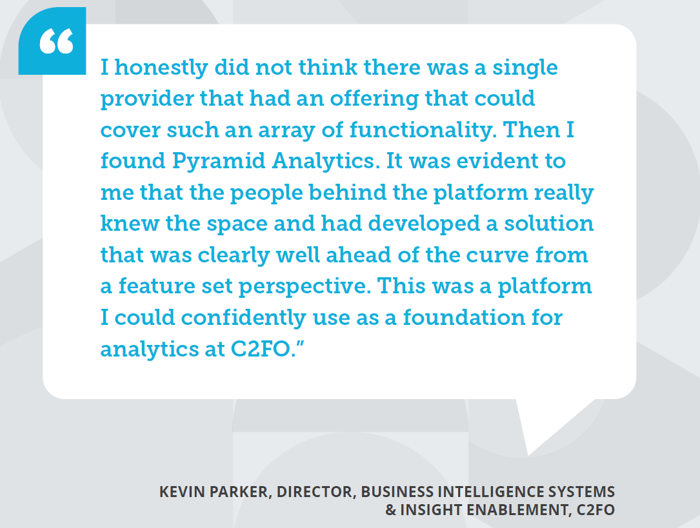
What’s Driving the Shift from BI to Decision Intelligence?
The Challenges of Legacy BI
A departmental, siloed, complex tools approach to BI & Analytics

Delays
due to data access issues

Low Adoption
due to poor experiences

Constraints
due to disjointed tools
Say Hello to Decision Intelligence
Enabling faster, more intelligent decisions with any data, for any person, and any analytics need.

Speed Up Insights
Provide instant access to any data at scale

Scale Adoption
Deploy AI-driven experiences for any person

Simplify Analytics
Provision any analytic need
Download Your Personal
Copy of the eBook
-1.png?width=347&height=205&name=Insights%20for%20everyone%20cover%20(1)-1.png)
Fill out the form to receive your copy of the eBook.
Download the eBook
A Purpose-Built Platform
Pyramid Decision Intelligence Platform
Unified, complete and super-fast platform with flexible deployment options.
- Present deeper insights
Provide multi-source direct access to any data at
scale in a single view - Reduce one-off requests
Deploy AI-driven, governed self-service experiences for any person - Develop analytics assets faster
Provision any analytics need with an integrated pipeline and a virtual semantic layer to future-proof analytic assets
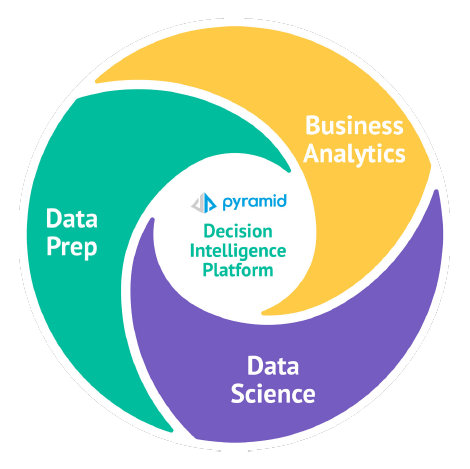
KASH Tech's Approach to Choosing the Right Technology Platform
At KASH Tech, we believe in taking a vendor-agnostic approach to building our client's data and analytics strategies. Rather than focusing on selling a specific software or platform, we approach data and analytics strategies holistically. This means we will evaluate your business's unique needs to advise on the best tool or platform for your specific needs and audience.
We follow a systematic approach to addressing the requirements of our clients when it comes to digital transformation challenges by employing a four-phase process that ensures each client receives a custom solution tailored to their unique configuration.
The methodology involves a thorough analysis that provides a comprehensive strategy for successful implementation. If you want to learn how to unlock advanced business intelligence, eliminate data silos, and create actionable business insights, download KASH Tech's Advanced Analytics Playbook eBook for free. It's a valuable resource for organizations wanting breakthrough business insights.
If you’re ready to explore solutions, request a data and analytics discovery call from the KASH Tech team.
-1.png?width=1080&height=639&name=Insights%20for%20everyone%20cover%20(1)-1.png)
